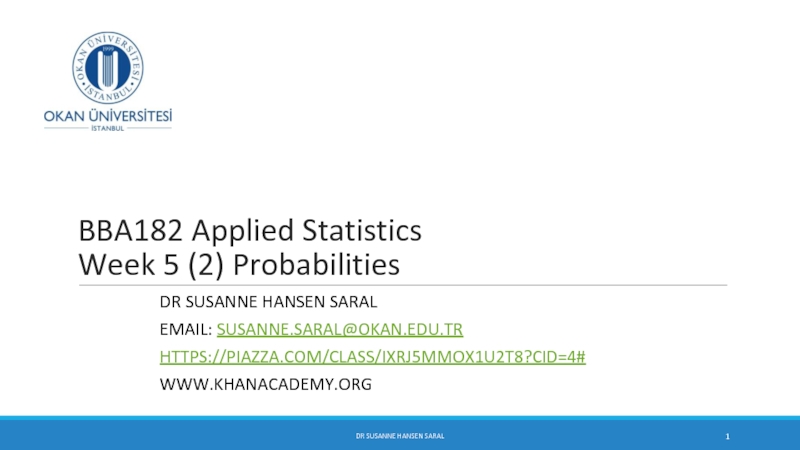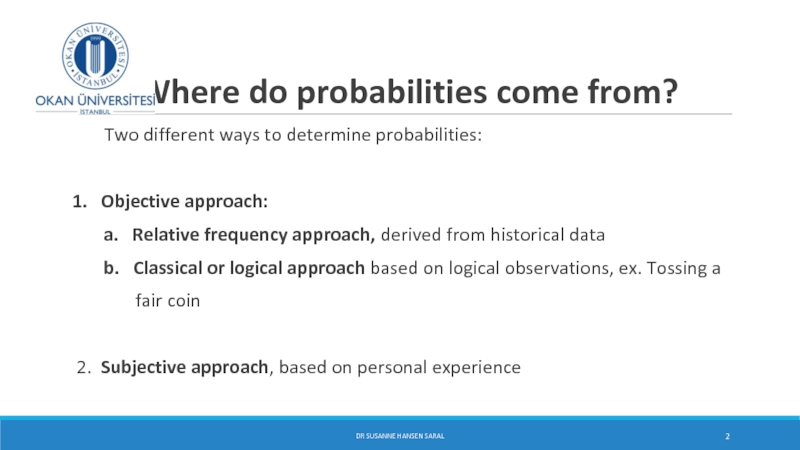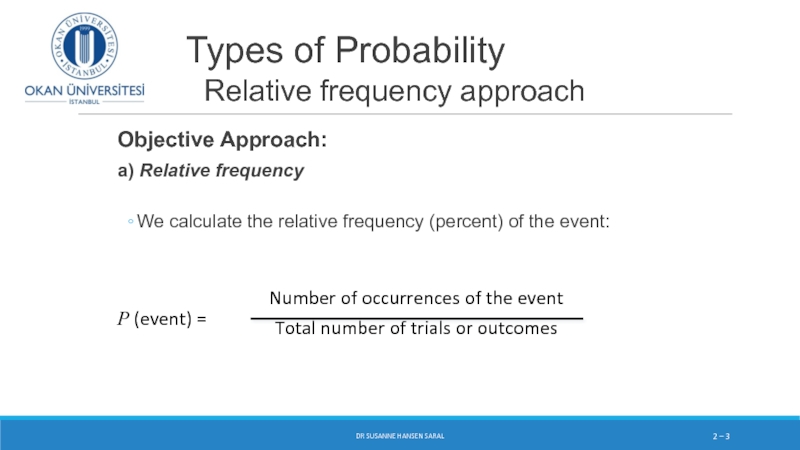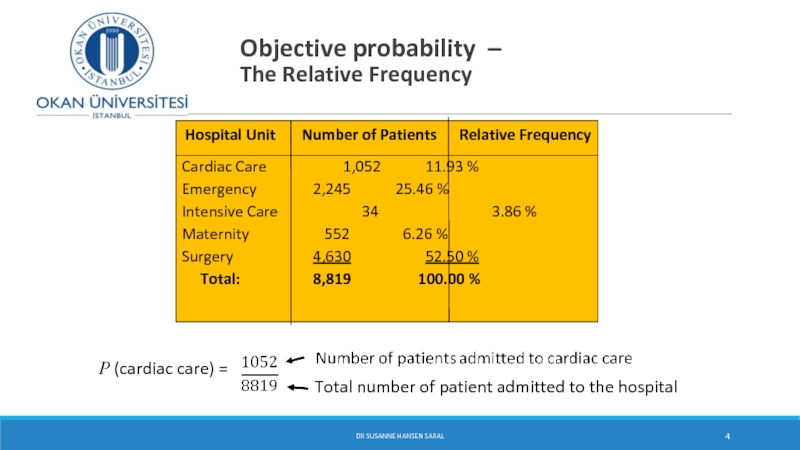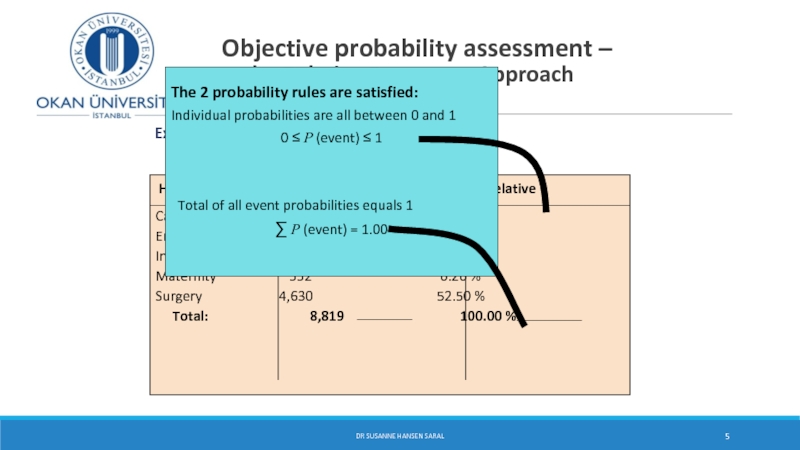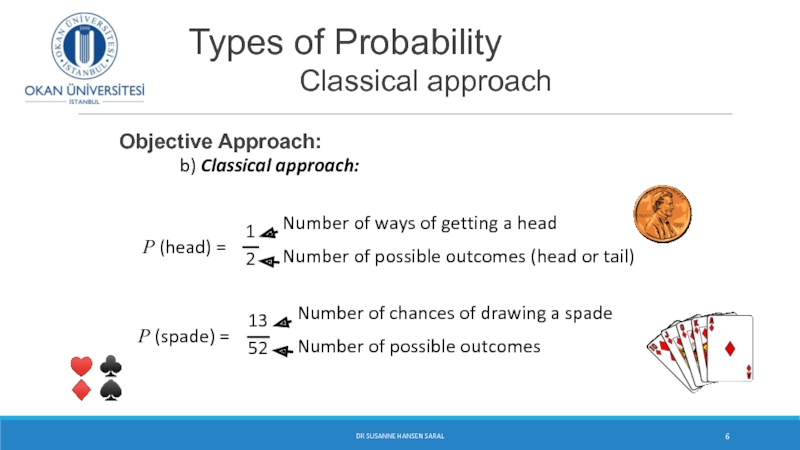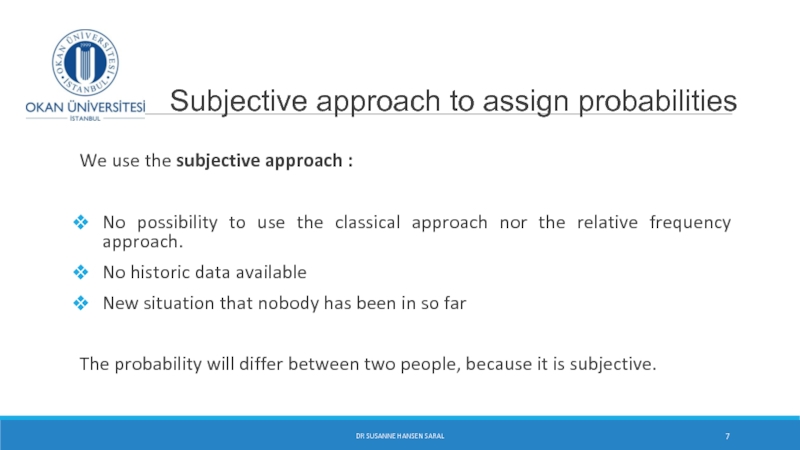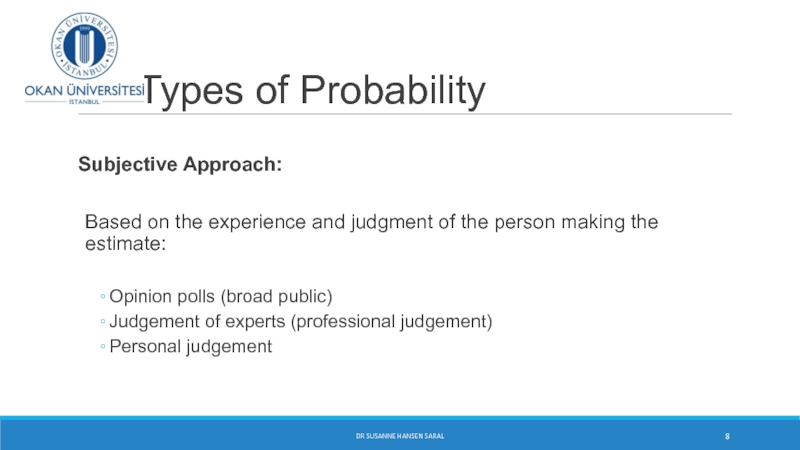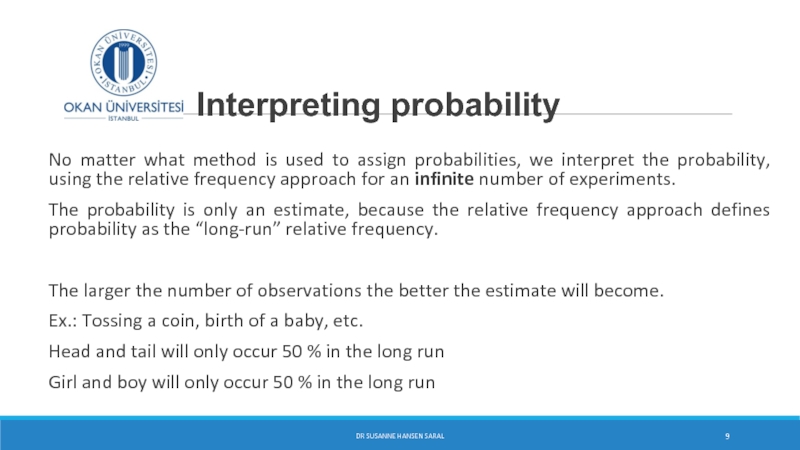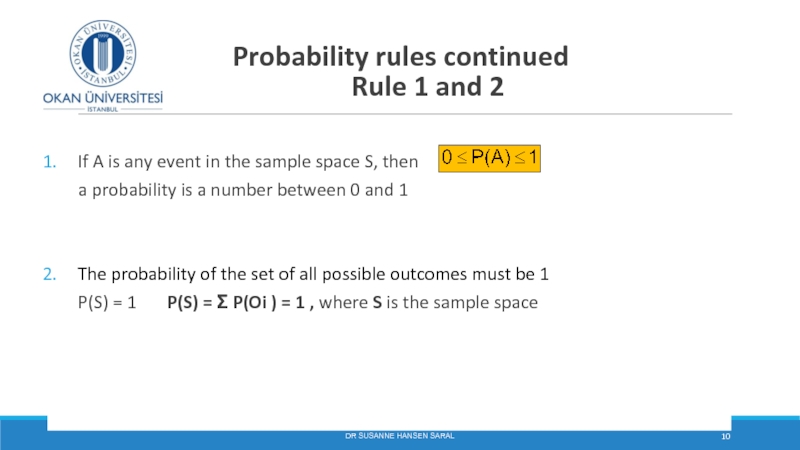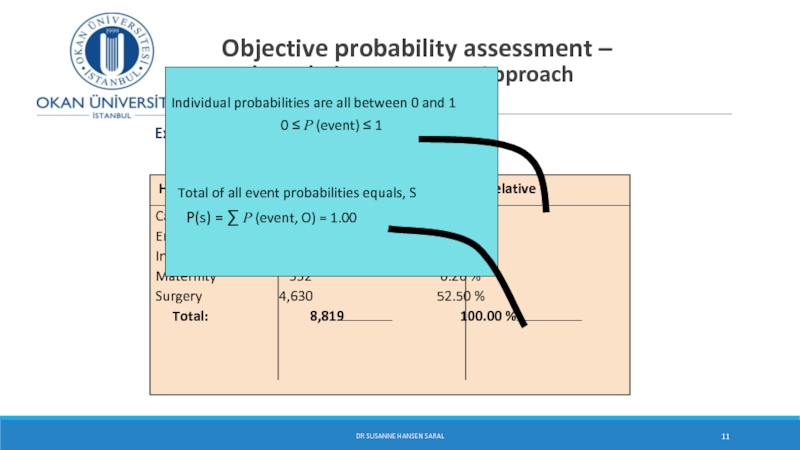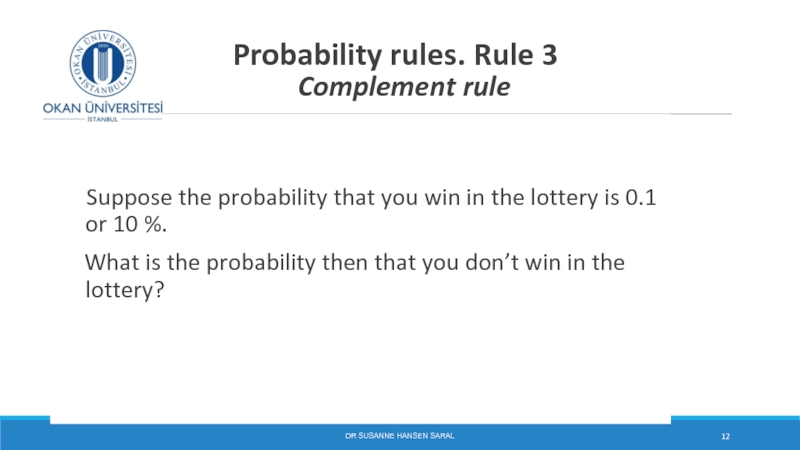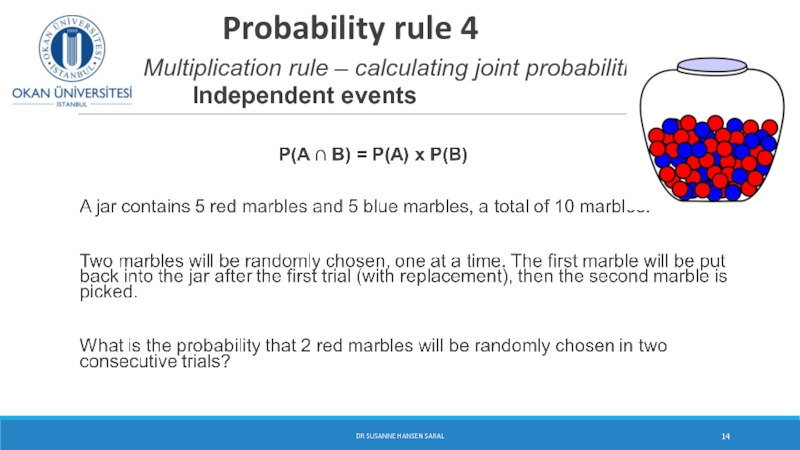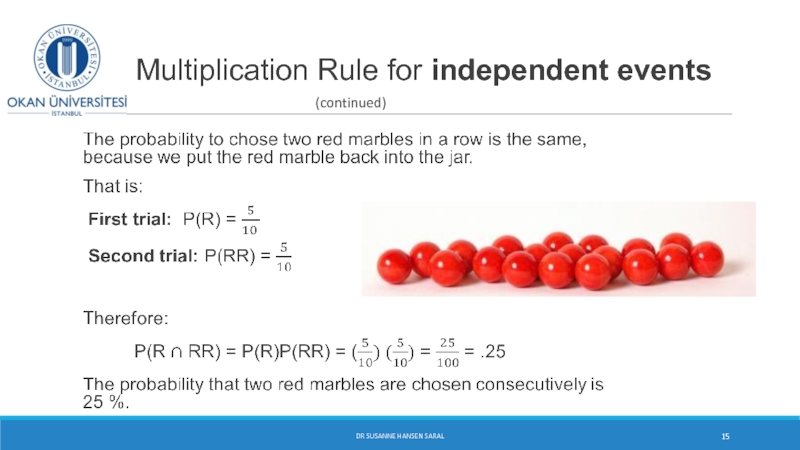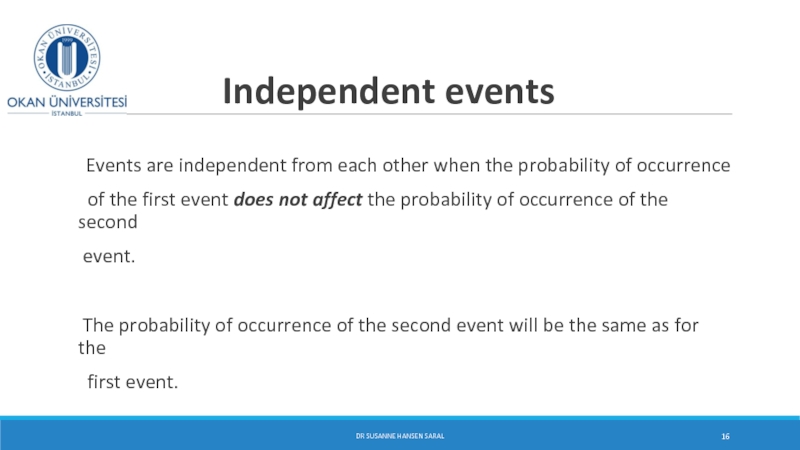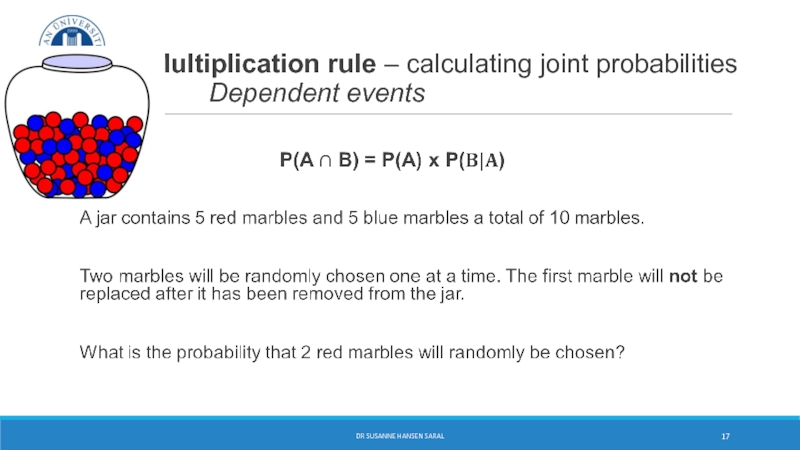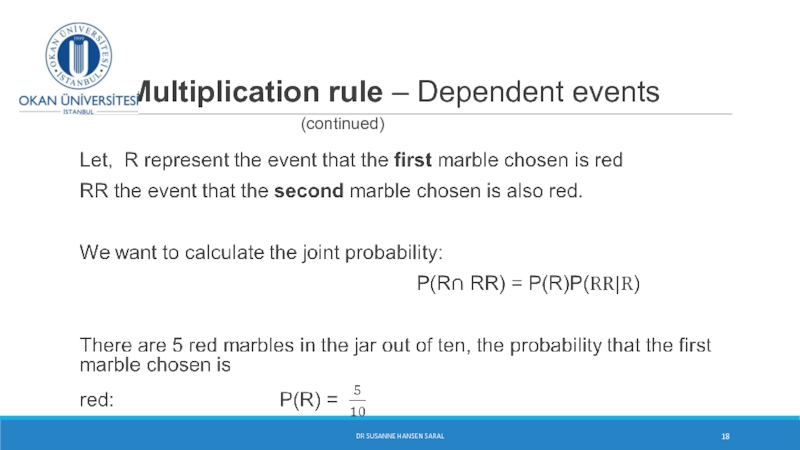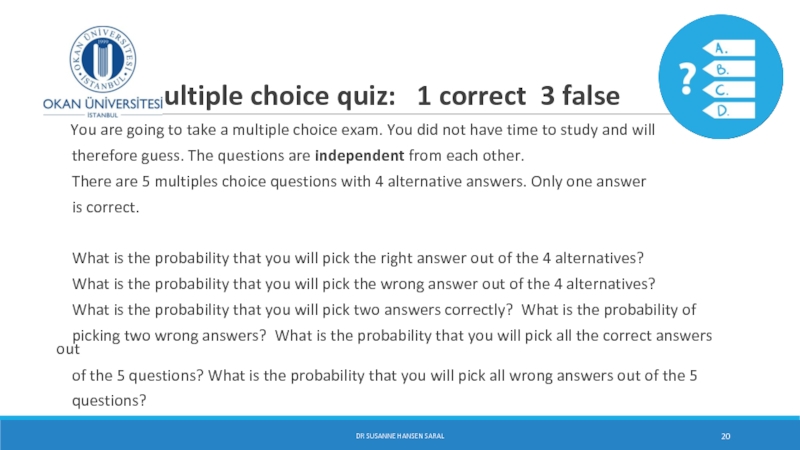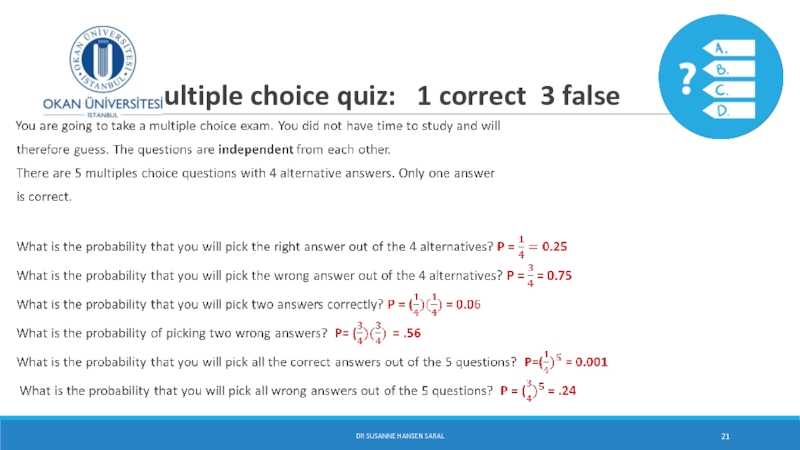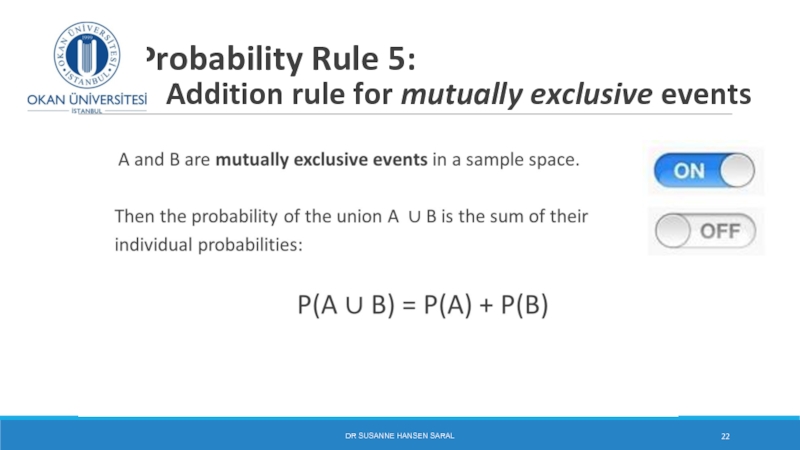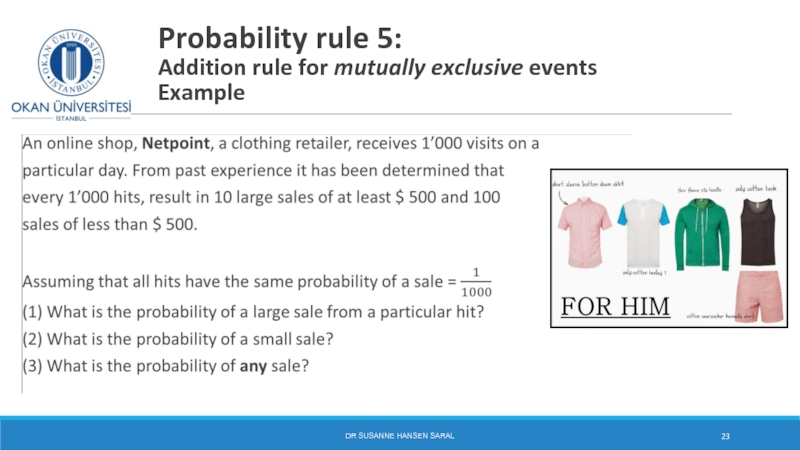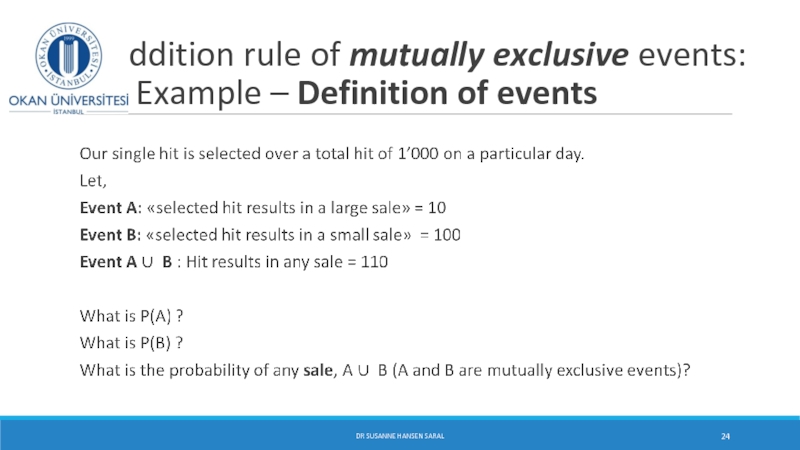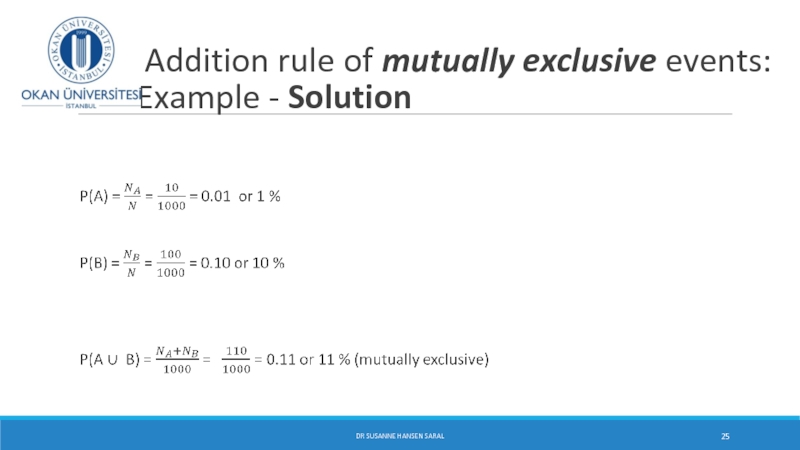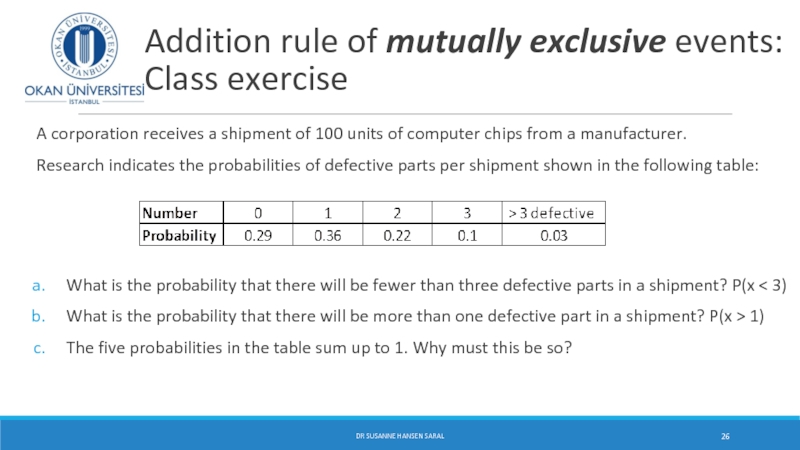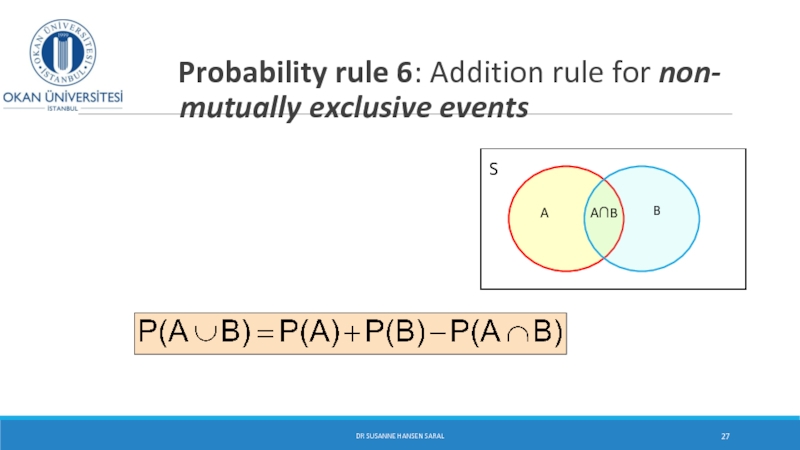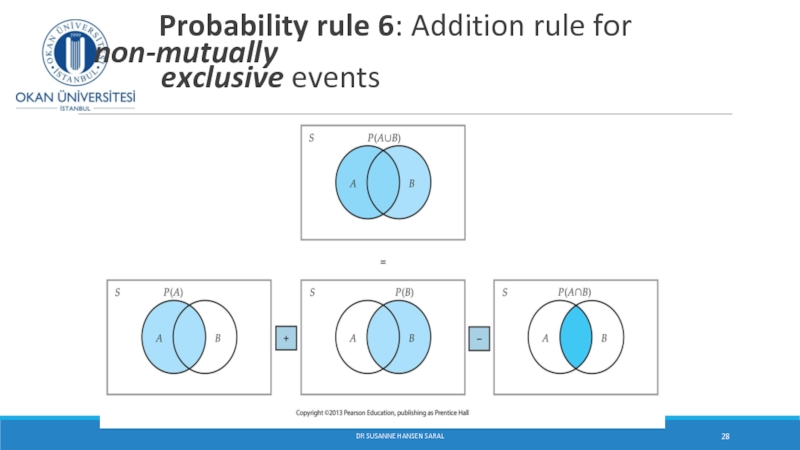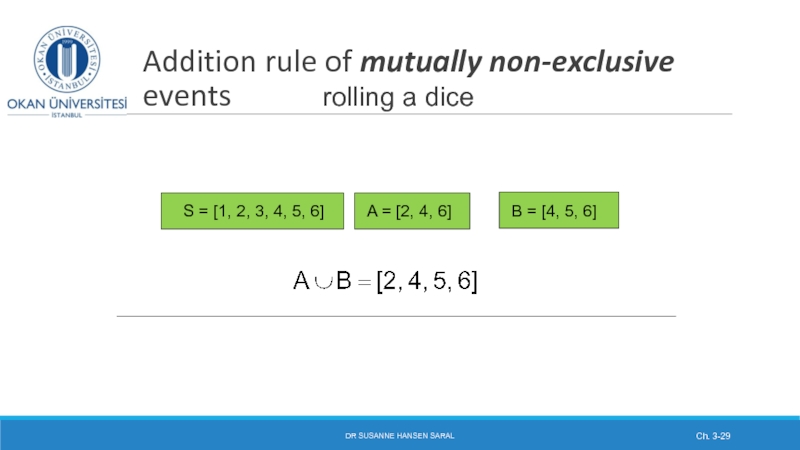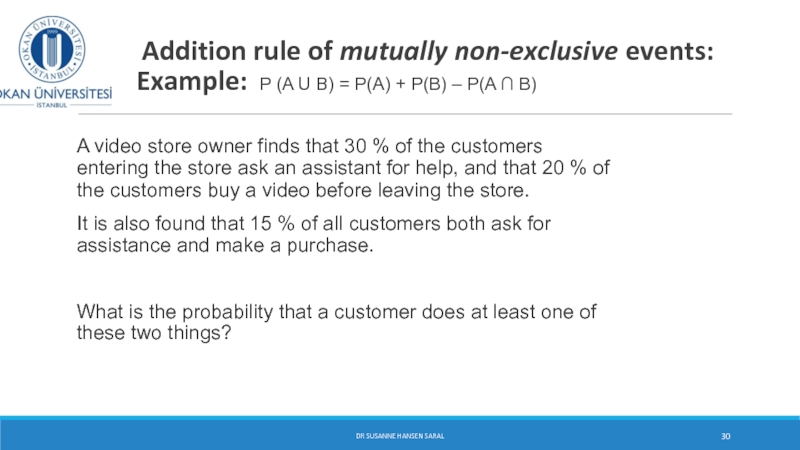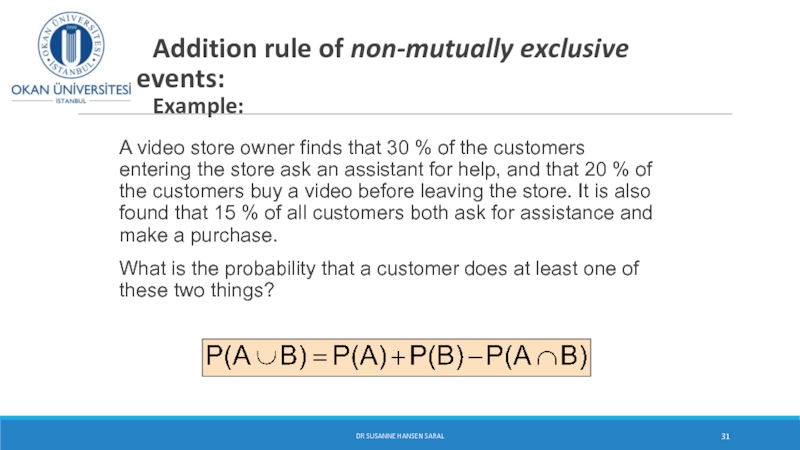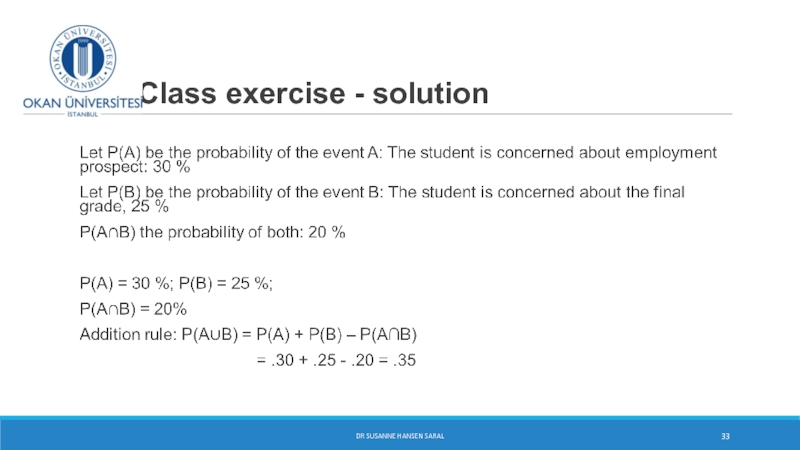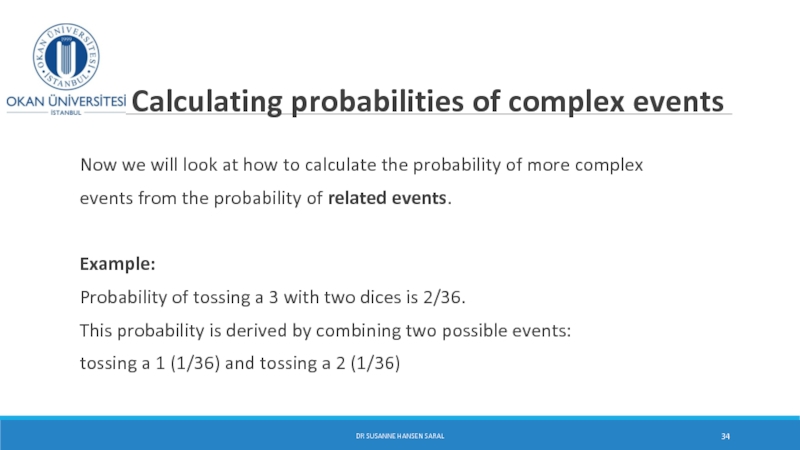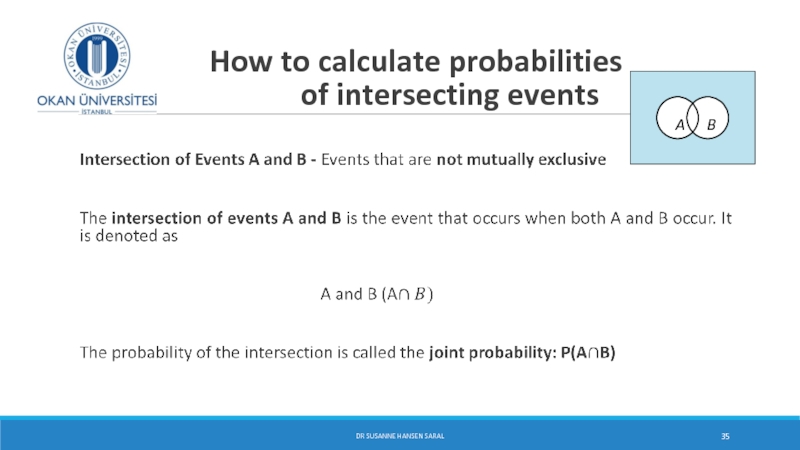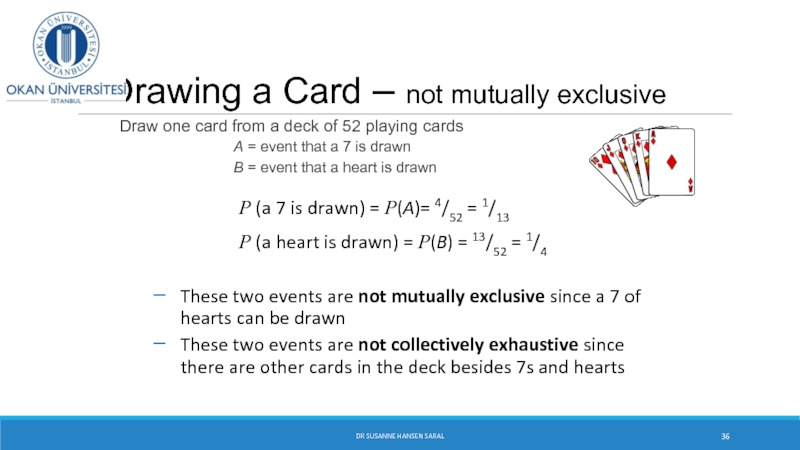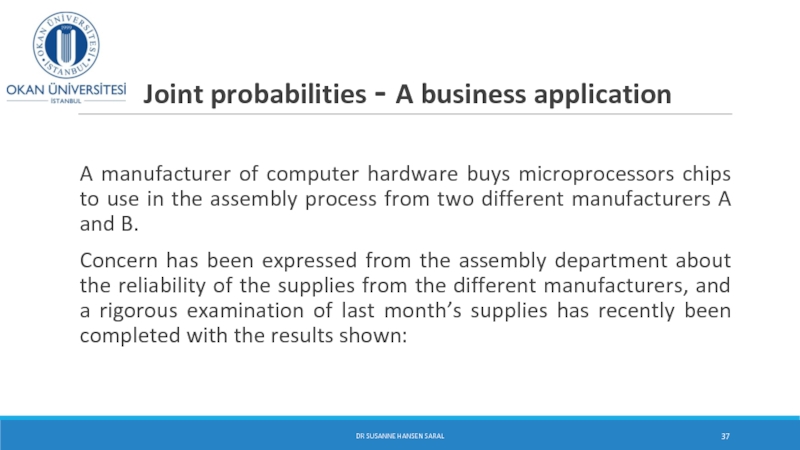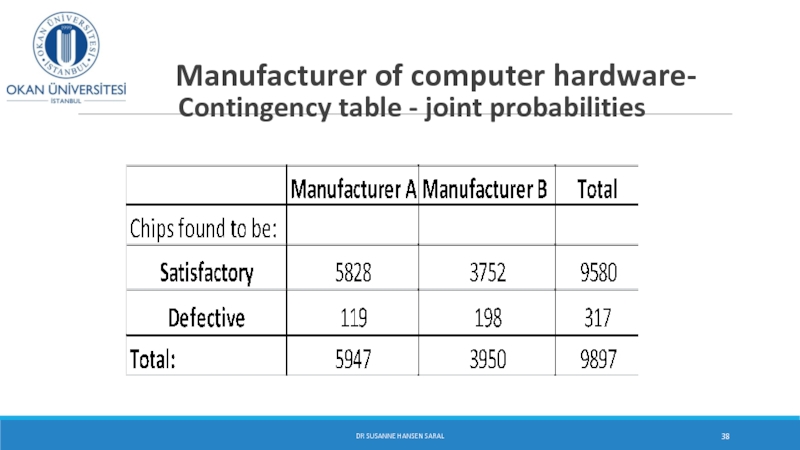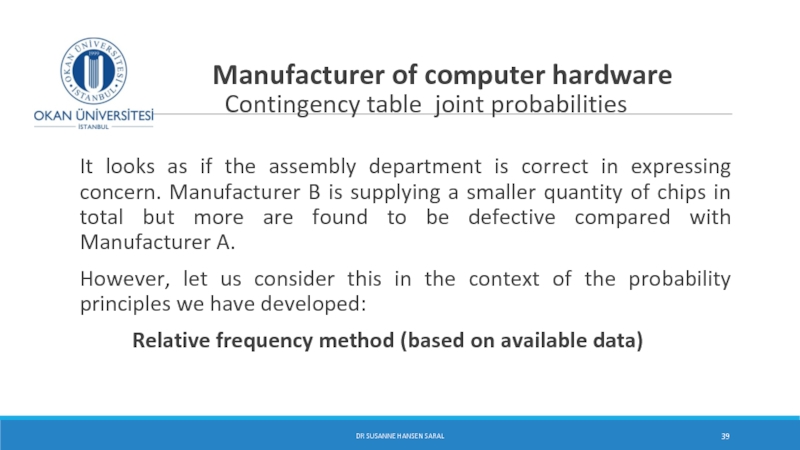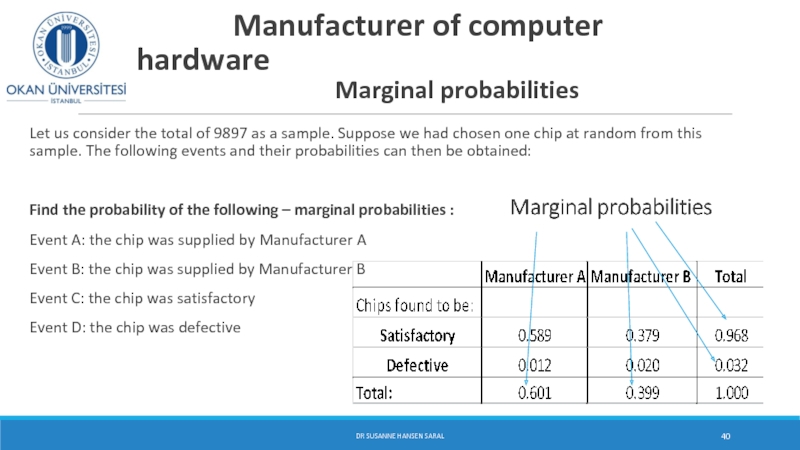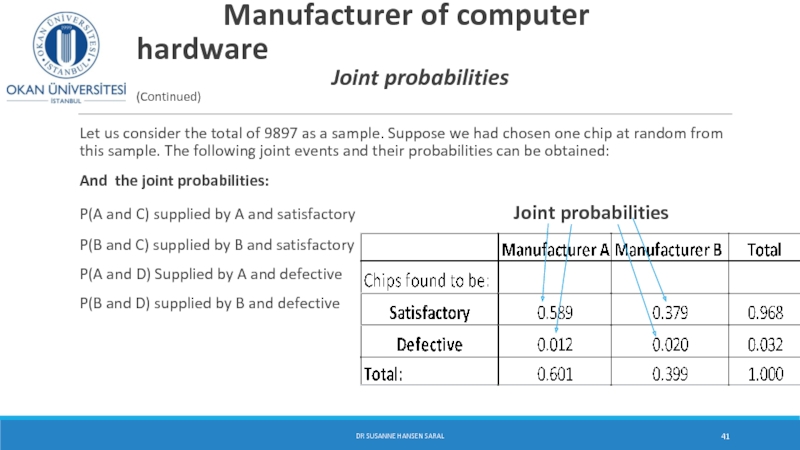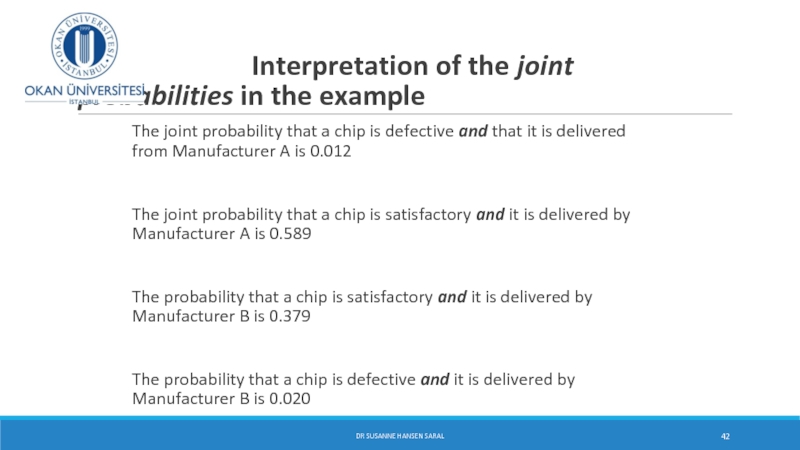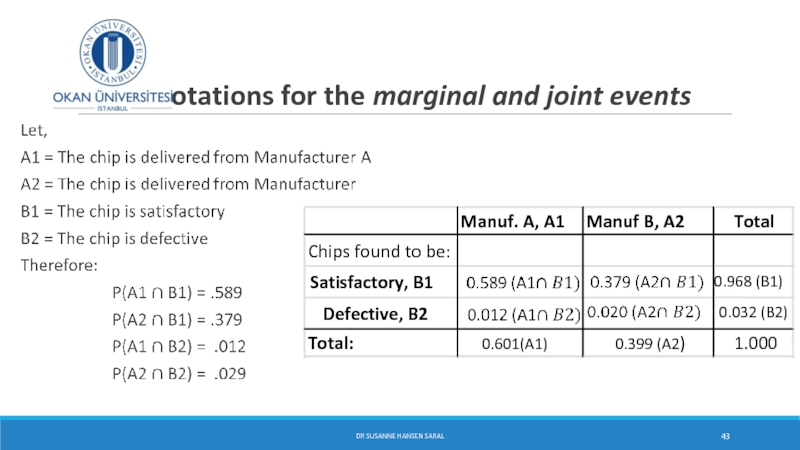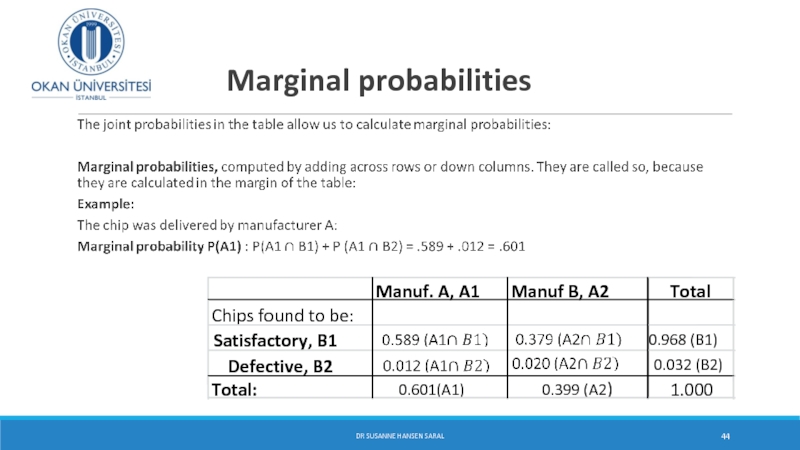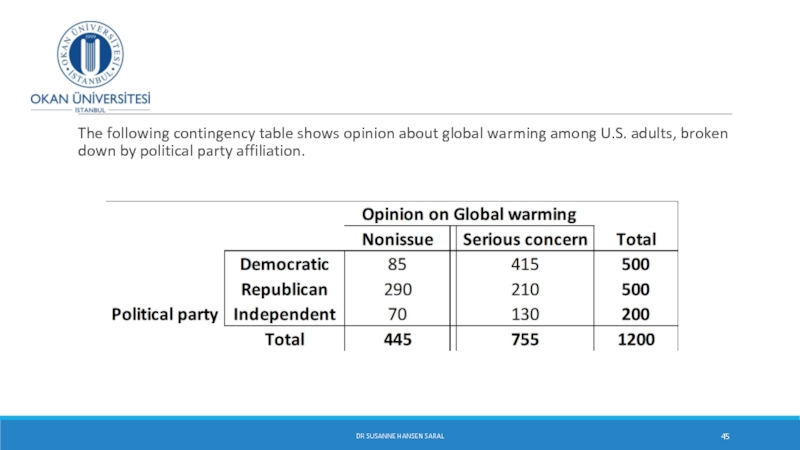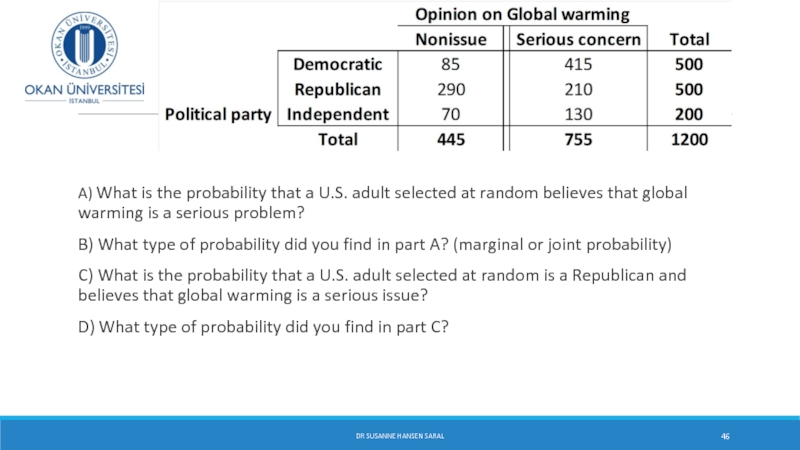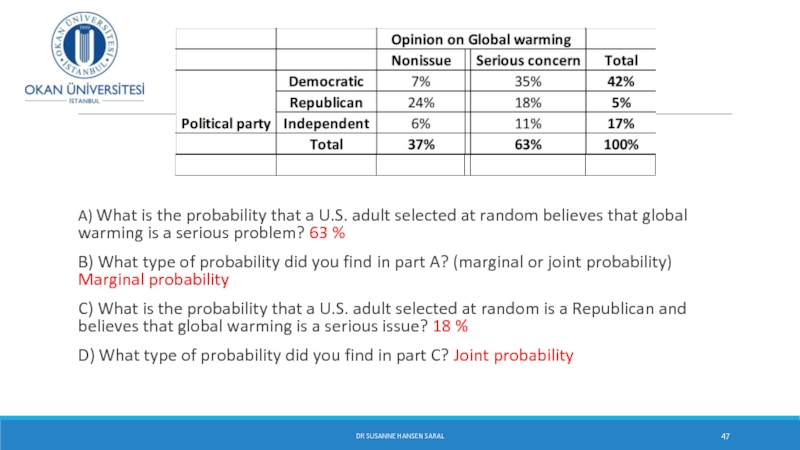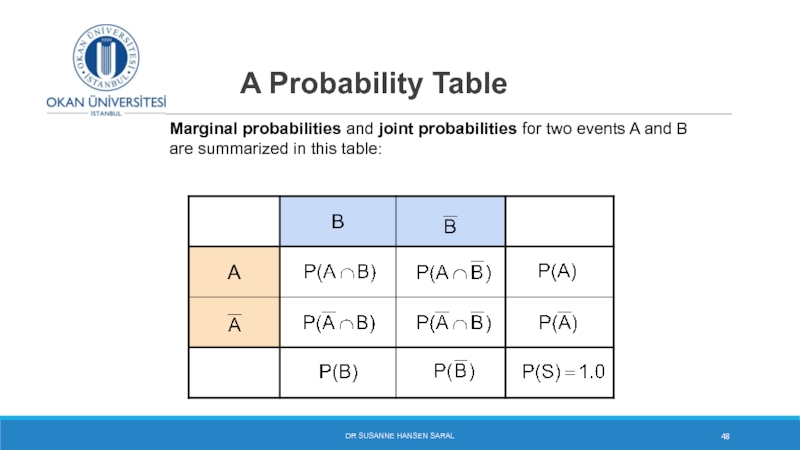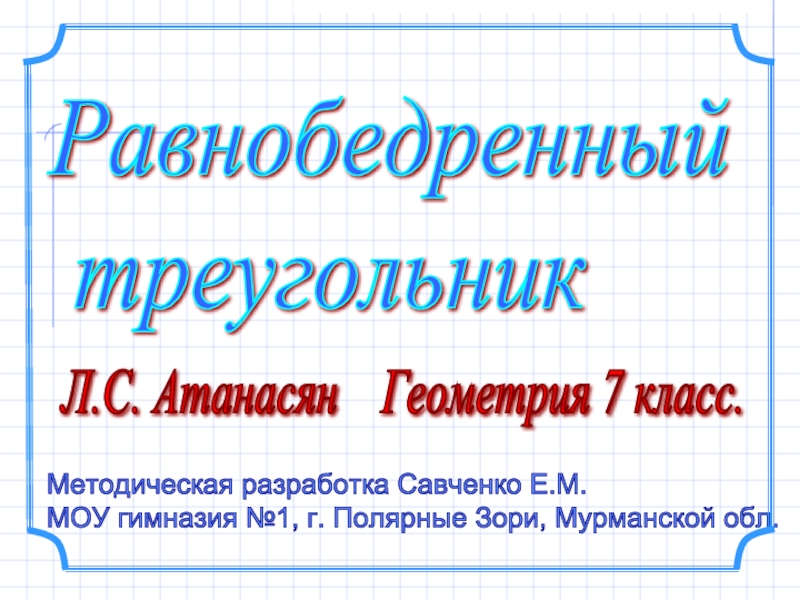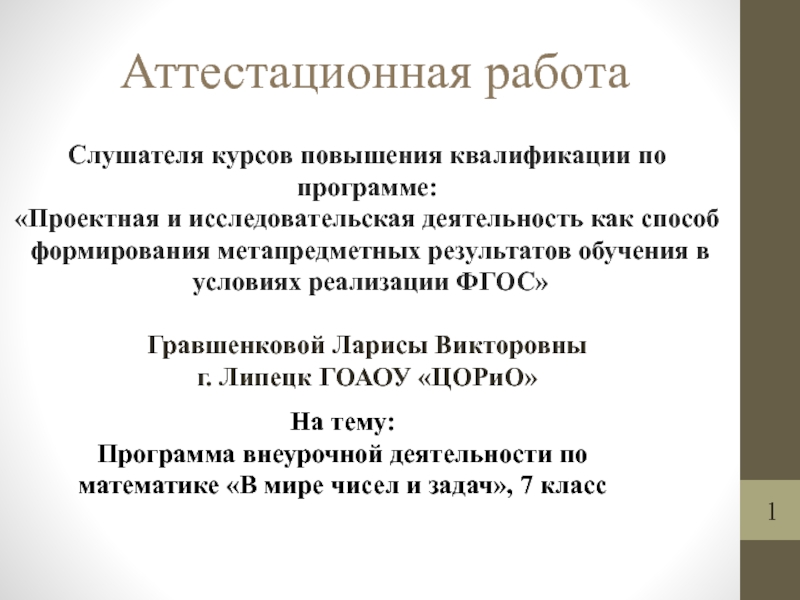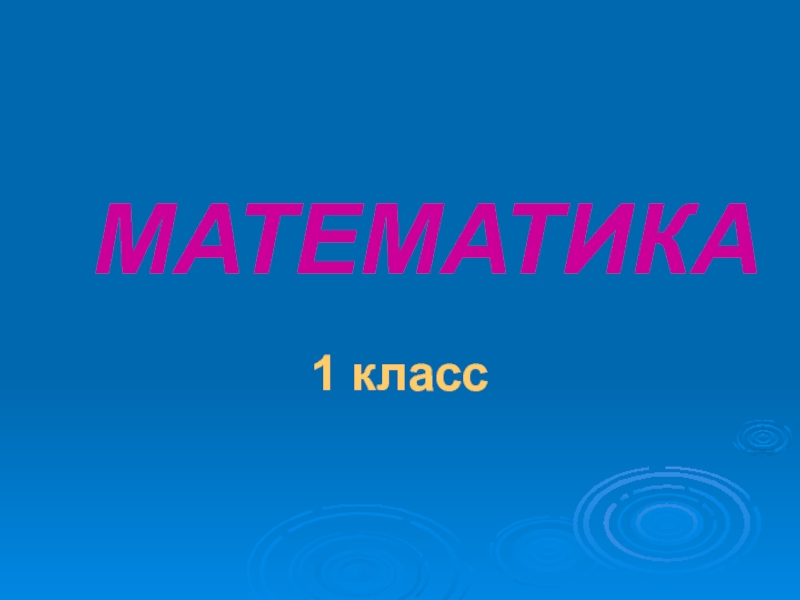- Главная
- Разное
- Дизайн
- Бизнес и предпринимательство
- Аналитика
- Образование
- Развлечения
- Красота и здоровье
- Финансы
- Государство
- Путешествия
- Спорт
- Недвижимость
- Армия
- Графика
- Культурология
- Еда и кулинария
- Лингвистика
- Английский язык
- Астрономия
- Алгебра
- Биология
- География
- Детские презентации
- Информатика
- История
- Литература
- Маркетинг
- Математика
- Медицина
- Менеджмент
- Музыка
- МХК
- Немецкий язык
- ОБЖ
- Обществознание
- Окружающий мир
- Педагогика
- Русский язык
- Технология
- Физика
- Философия
- Химия
- Шаблоны, картинки для презентаций
- Экология
- Экономика
- Юриспруденция
Probabilities. Week 5 (2) презентация
Содержание
- 1. Probabilities. Week 5 (2)
- 2. Where do probabilities come from?
- 3. Types of Probability
- 4. Objective probability –
- 5. Objective probability assessment –
- 6. Types of Probability
- 7. Subjective approach to
- 8. Types of Probability Subjective Approach:
- 9. Interpreting probability No matter what method
- 10. Probability rules continued
- 11. Objective probability assessment –
- 12. Probability rules. Rule 3
- 13. Probability rules. Rule 3
- 14. Probability rule
- 15. Multiplication Rule for independent events (continued) DR SUSANNE HANSEN SARAL
- 17. Multiplication rule – calculating joint probabilities Dependent events DR SUSANNE HANSEN SARAL
- 18. Multiplication rule – Dependent events (continued) DR SUSANNE HANSEN SARAL
- 19. Multiplication Rule - Dependent events
- 20. Multiple choice quiz: 1 correct 3
- 21. Multiple choice quiz: 1 correct 3 false DR SUSANNE HANSEN SARAL
- 22. Probability Rule 5:
- 23. Probability rule 5: Addition rule for
- 24. Addition rule of mutually exclusive events:
- 25. Addition rule of mutually exclusive events:
- 26. Addition rule of mutually exclusive events: Class
- 27. Probability rule 6:
- 28. DR SUSANNE HANSEN SARAL
- 29. Addition rule of mutually non-exclusive events rolling
- 30. Addition rule of mutually non-exclusive events:
- 31. Addition rule of non-mutually exclusive
- 32. Addition rule of non-mutually exclusive
- 33. Class exercise - solution DR SUSANNE HANSEN SARAL
- 34. Calculating probabilities of complex events Now
- 35. How
- 36. Drawing a Card – not mutually exclusive
- 37. Joint probabilities - A business
- 38. Manufacturer of computer hardware-
- 39. Manufacturer
- 43. Notations for the marginal and joint events DR SUSANNE HANSEN SARAL
- 44. Marginal probabilities DR SUSANNE HANSEN SARAL
- 45. The
- 48. A Probability Table DR SUSANNE HANSEN SARAL
Слайд 1BBA182 Applied Statistics
Week 5 (2) Probabilities
DR SUSANNE HANSEN SARAL
EMAIL: SUSANNE.SARAL@OKAN.EDU.TR
HTTPS://PIAZZA.COM/CLASS/IXRJ5MMOX1U2T8?CID=4#
WWW.KHANACADEMY.ORG
DR
Слайд 2 Where do probabilities come from?
Two different ways
1. Objective approach:
a. Relative frequency approach, derived from historical data
b. Classical or logical approach based on logical observations, ex. Tossing a
fair coin
2. Subjective approach, based on personal experience
DR SUSANNE HANSEN SARAL
Слайд 3 Types of Probability Relative
Objective Approach:
a) Relative frequency
We calculate the relative frequency (percent) of the event:
2 –
DR SUSANNE HANSEN SARAL
Слайд 4
Objective probability –
The Relative Frequency
DR SUSANNE HANSEN SARAL
Hospital Unit Number of Patients Relative Frequency
Cardiac Care 1,052 11.93 %
Emergency 2,245 25.46 %
Intensive Care 34 3.86 %
Maternity 552 6.26 %
Surgery 4,630 52.50 %
Total: 8,819 100.00 %
P (cardiac care) =
Total number of patient admitted to the hospital
Слайд 5
Objective probability assessment –
The Relative Frequency Approach
DR SUSANNE HANSEN SARAL
Example: Hospital Patients by Unit per semester
Hospital Unit Number of Patients Relative Frequency
Cardiac Care 1,052 11.93 %
Emergency 2,245 25.46 %
Intensive Care 340 3.86 %
Maternity 552 6.26 %
Surgery 4,630 52.50 %
Total: 8,819 100.00 %
The 2 probability rules are satisfied:
Individual probabilities are all between 0 and 1
0 ≤ P (event) ≤ 1
Total of all event probabilities equals 1
∑ P (event) = 1.00
Слайд 6 Types of Probability
Objective Approach:
DR SUSANNE HANSEN SARAL
b) Classical approach:
♥ ♣ ♦ ♠
Слайд 7 Subjective approach to assign probabilities
We use the
No possibility to use the classical approach nor the relative frequency approach.
No historic data available
New situation that nobody has been in so far
The probability will differ between two people, because it is subjective.
DR SUSANNE HANSEN SARAL
Слайд 8 Types of Probability
Subjective Approach:
Based on the experience and judgment of the
Opinion polls (broad public)
Judgement of experts (professional judgement)
Personal judgement
DR SUSANNE HANSEN SARAL
Слайд 9 Interpreting probability
No matter what method is used to assign probabilities, we
The probability is only an estimate, because the relative frequency approach defines probability as the “long-run” relative frequency.
The larger the number of observations the better the estimate will become.
Ex.: Tossing a coin, birth of a baby, etc.
Head and tail will only occur 50 % in the long run
Girl and boy will only occur 50 % in the long run
DR SUSANNE HANSEN SARAL
Слайд 10
Probability rules continued
If A is any event in the sample space S, then
a probability is a number between 0 and 1
The probability of the set of all possible outcomes must be 1
P(S) = 1 P(S) = Σ P(Oi ) = 1 , where S is the sample space
DR SUSANNE HANSEN SARAL
Слайд 11
Objective probability assessment –
The Relative Frequency Approach
DR SUSANNE HANSEN SARAL
Example: Hospital Patients by Unit per semester
Hospital Unit Number of Patients Relative Frequency
Cardiac Care 1,052 11.93 %
Emergency 2,245 25.46 %
Intensive Care 340 3.86 %
Maternity 552 6.26 %
Surgery 4,630 52.50 %
Total: 8,819 100.00 %
Individual probabilities are all between 0 and 1
0 ≤ P (event) ≤ 1
Total of all event probabilities equals, S
P(s) = ∑ P (event, O) = 1.00
Слайд 12
Probability rules. Rule 3
Complement
Suppose the probability that you win in the lottery is 0.1 or 10 %.
What is the probability then that you don’t win in the lottery?
DR SUSANNE HANSEN SARAL
Слайд 14 Probability rule 4 Multiplication rule
DR SUSANNE HANSEN SARAL
Слайд 16 Independent events
Events
of the first event does not affect the probability of occurrence of the second
event.
The probability of occurrence of the second event will be the same as for the
first event.
DR SUSANNE HANSEN SARAL
Слайд 17 Multiplication rule – calculating joint probabilities
Dependent events
DR SUSANNE HANSEN SARAL
Слайд 20 Multiple choice quiz: 1 correct 3 false
You
therefore guess. The questions are independent from each other.
There are 5 multiples choice questions with 4 alternative answers. Only one answer
is correct.
What is the probability that you will pick the right answer out of the 4 alternatives?
What is the probability that you will pick the wrong answer out of the 4 alternatives?
What is the probability that you will pick two answers correctly? What is the probability of
picking two wrong answers? What is the probability that you will pick all the correct answers out
of the 5 questions? What is the probability that you will pick all wrong answers out of the 5
questions?
DR SUSANNE HANSEN SARAL
Слайд 23
Probability rule 5:
Addition rule for mutually exclusive events
Example
DR SUSANNE HANSEN SARAL
Слайд 24 Addition rule of mutually exclusive events: Example
DR SUSANNE HANSEN SARAL
Слайд 26Addition rule of mutually exclusive events: Class exercise
A corporation receives
Research indicates the probabilities of defective parts per shipment shown in the following table:
What is the probability that there will be fewer than three defective parts in a shipment? P(x < 3)
What is the probability that there will be more than one defective part in a shipment? P(x > 1)
The five probabilities in the table sum up to 1. Why must this be so?
DR SUSANNE HANSEN SARAL
Слайд 27 Probability rule 6: Addition rule for non-
A∩B
A
B
S
DR SUSANNE HANSEN SARAL
Слайд 28
DR SUSANNE HANSEN SARAL
Probability rule 6: Addition
Слайд 29Addition rule of mutually non-exclusive events rolling a dice
DR SUSANNE HANSEN
Ch. 3-
S = [1, 2, 3, 4, 5, 6] A = [2, 4, 6] B = [4, 5, 6]
Слайд 30 Addition rule of mutually non-exclusive events: Example: P (A U
A video store owner finds that 30 % of the customers entering the store ask an assistant for help, and that 20 % of the customers buy a video before leaving the store.
It is also found that 15 % of all customers both ask for assistance and make a purchase.
What is the probability that a customer does at least one of these two things?
DR SUSANNE HANSEN SARAL
Слайд 31 Addition rule of non-mutually exclusive events:
A video store owner finds that 30 % of the customers entering the store ask an assistant for help, and that 20 % of the customers buy a video before leaving the store. It is also found that 15 % of all customers both ask for assistance and make a purchase.
What is the probability that a customer does at least one of these two things?
DR SUSANNE HANSEN SARAL
Слайд 32 Addition rule of non-mutually exclusive events:
It was estimated that 30 % of all students in their 4th year at a university campus were concerned about employment future. 25 % were seriously concerned about grades, and 20 % were seriously concerned about both.
What is the probability that a randomly chosen 4th year student from this campus is seriously concerned with at least one of these two concerns?
DR SUSANNE HANSEN SARAL
Слайд 34Calculating probabilities of complex events
Now we will look at how to
events from the probability of related events.
Example:
Probability of tossing a 3 with two dices is 2/36.
This probability is derived by combining two possible events:
tossing a 1 (1/36) and tossing a 2 (1/36)
DR SUSANNE HANSEN SARAL
Слайд 36 Drawing a Card – not mutually exclusive
Draw one card from a
A = event that a 7 is drawn
B = event that a heart is drawn
DR SUSANNE HANSEN SARAL
P (a 7 is drawn) = P(A)= 4/52 = 1/13
P (a heart is drawn) = P(B) = 13/52 = 1/4
These two events are not mutually exclusive since a 7 of hearts can be drawn
These two events are not collectively exhaustive since there are other cards in the deck besides 7s and hearts
Слайд 37 Joint probabilities - A business application
A manufacturer of computer
Concern has been expressed from the assembly department about the reliability of the supplies from the different manufacturers, and a rigorous examination of last month’s supplies has recently been completed with the results shown:
DR SUSANNE HANSEN SARAL
Слайд 38 Manufacturer of computer hardware-
DR SUSANNE HANSEN SARAL
Слайд 39 Manufacturer of computer hardware
It looks as if the assembly department is correct in expressing concern. Manufacturer B is supplying a smaller quantity of chips in total but more are found to be defective compared with Manufacturer A.
However, let us consider this in the context of the probability principles we have developed:
Relative frequency method (based on available data)
DR SUSANNE HANSEN SARAL
Слайд 40 Manufacturer of computer
Let us consider the total of 9897 as a sample. Suppose we had chosen one chip at random from this sample. The following events and their probabilities can then be obtained:
Find the probability of the following – marginal probabilities :
Event A: the chip was supplied by Manufacturer A
Event B: the chip was supplied by Manufacturer B
Event C: the chip was satisfactory
Event D: the chip was defective
DR SUSANNE HANSEN SARAL
Слайд 41 Manufacturer of computer
Let us consider the total of 9897 as a sample. Suppose we had chosen one chip at random from this sample. The following joint events and their probabilities can be obtained:
And the joint probabilities:
P(A and C) supplied by A and satisfactory Joint probabilities
P(B and C) supplied by B and satisfactory
P(A and D) Supplied by A and defective
P(B and D) supplied by B and defective
DR SUSANNE HANSEN SARAL
Слайд 42
The joint probability that a chip is defective and that it is delivered from Manufacturer A is 0.012
The joint probability that a chip is satisfactory and it is delivered by Manufacturer A is 0.589
The probability that a chip is satisfactory and it is delivered by Manufacturer B is 0.379
The probability that a chip is defective and it is delivered by Manufacturer B is 0.020
DR SUSANNE HANSEN SARAL
Слайд 45
The following contingency table shows opinion
DR SUSANNE HANSEN SARAL
Слайд 46
A) What is the probability that a U.S. adult selected at random believes that global warming is a serious problem?
B) What type of probability did you find in part A? (marginal or joint probability)
C) What is the probability that a U.S. adult selected at random is a Republican and believes that global warming is a serious issue?
D) What type of probability did you find in part C?
DR SUSANNE HANSEN SARAL
Слайд 47
A) What is the probability that a U.S. adult selected at random believes that global warming is a serious problem? 63 %
B) What type of probability did you find in part A? (marginal or joint probability) Marginal probability
C) What is the probability that a U.S. adult selected at random is a Republican and believes that global warming is a serious issue? 18 %
D) What type of probability did you find in part C? Joint probability
DR SUSANNE HANSEN SARAL
